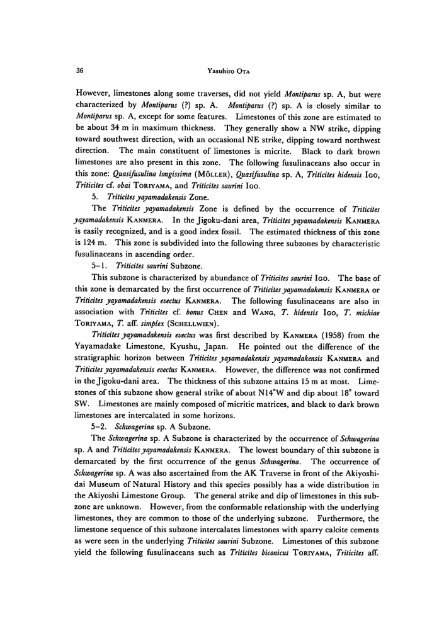Biostratigraphy of the Akiyoshi Limestone Group,
Biostratigraphy of the Akiyoshi Limestone Group,
Biostratigraphy of the Akiyoshi Limestone Group,
You also want an ePaper? Increase the reach of your titles
YUMPU automatically turns print PDFs into web optimized ePapers that Google loves.
36 Yasuhiro Ota<br />
However, limestones along some traverses, did not yield Montiparus sp. A, but were<br />
characterized by Montiparus () sp. A. Montiparus () sp. A is closely similar to<br />
Montiparus sp. A, except for some features. <strong>Limestone</strong>s <strong>of</strong> this zone are estimated to<br />
be about 34 m in maximum thickness. They generally show a NW strike, dipping<br />
toward southwest direction, with an occasional NE strike, dipping toward northwest<br />
direction. The main constituent <strong>of</strong> limestones is micrite. Black to dark brown<br />
limestones are also present in this zone. The following fusuhnaceans also occur in<br />
this zone: Quasifusulina longissima (Moller), Quasifusulina sp. A, Triticites hidensis Igo,<br />
Triticites cf. obai Toriyama, and Triticites saurini Igo.<br />
5. Triticitesyayamadakensis Zone.<br />
The Triticites yayamadakensis Zone is defined by <strong>the</strong> occurrence <strong>of</strong> Triticites<br />
yayamadakensis Kanmera. In <strong>the</strong> Jigoku-dani area, Triticites yayamadakensis Kanmera<br />
is easily recognized, and is a good index fossil. The estimated thickness <strong>of</strong> this zone<br />
is 124m. This zone is subdivided into <strong>the</strong> following three subzones by characteristic<br />
fusuhnaceans in ascending order.<br />
5-1. Triticites saurini Subzone.<br />
This subzone is characterized by abundance <strong>of</strong> Triticites saurini Igo. The base <strong>of</strong><br />
this zone is demarcated by <strong>the</strong> first occurrence <strong>of</strong> Triticitesyayamadakensis Kanmera or<br />
Triticites yayamadakensis evectus Kanmera. The following fusuhnaceans are also in<br />
association with Triticites cf. bonus Chen and Wang, T. hidensis Igo, T. michiae<br />
Toriyama, T. aff. simplex (Schellwien).<br />
Triticites yayamadakensis evectus was first described by Kanmera (1958) from <strong>the</strong><br />
Yayamadake <strong>Limestone</strong>, Kyushu, Japan. He pointed out <strong>the</strong> difference <strong>of</strong> <strong>the</strong><br />
stratigraphic horizon between Triticites yayamadakensis yayamadakensis Kanmera and<br />
Triticitesyayamadakensis evectus Kanmera. However, <strong>the</strong> difference was not confirmed<br />
in <strong>the</strong> Jigoku-dani area. The thickness <strong>of</strong> this subzone attains 15 m at most. Lime<br />
stones <strong>of</strong> this subzone show general strike <strong>of</strong> about N14°W and dip about 18° toward<br />
SW. <strong>Limestone</strong>s are mainly composed <strong>of</strong> micritic matrices, and black to dark brown<br />
limestones are intercalated in some horizons.<br />
5-2. Schwagerina sp. A Subzone.<br />
The Schwagerina sp. A Subzone is characterized by <strong>the</strong> occurrence <strong>of</strong> Schwagerina<br />
sp. A and Triticitesyayamadakensis Kanmera. The lowest boundary <strong>of</strong> this subzone is<br />
demarcated by <strong>the</strong> first occurrence <strong>of</strong> <strong>the</strong> genus Schwagerina. The occurrence <strong>of</strong><br />
Schwagerina sp. A was also ascertained from <strong>the</strong> AK Traverse in front <strong>of</strong> <strong>the</strong> <strong>Akiyoshi</strong>dai<br />
Museum <strong>of</strong> Natural History and this species possibly has a wide distribution in<br />
<strong>the</strong> <strong>Akiyoshi</strong> <strong>Limestone</strong> <strong>Group</strong>. The general strike and dip <strong>of</strong> limestones in this subzone<br />
are unknown. However, from <strong>the</strong> conformable relationship with <strong>the</strong> underlying<br />
limestones, <strong>the</strong>y are common to those <strong>of</strong> <strong>the</strong> underlying subzone. Fur<strong>the</strong>rmore, <strong>the</strong><br />
limestone sequence <strong>of</strong> this subzone intercalates limestones with sparry calcite cements<br />
as were seen in <strong>the</strong> underlying Triticites saurini Subzone. <strong>Limestone</strong>s <strong>of</strong> this subzone<br />
yield <strong>the</strong> following fusuhnaceans such as Triticites biconicus Toriyama, Triticites aff.
















